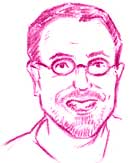home |
many pasts |
evidence |
www.history |
blackboard |
reference
talking history | syllabi | students | teachers | puzzle | about us
talking history | syllabi | students | teachers | puzzle | about us
Interview with Jay Pecora
 Jay Pecora has taught at Satellite Academy for the past
nine years. He has a BFA from the DePaul/Goodman School of Drama, an MA from the
Graduate Center, City University of New York and is working on a PhD in
Educational Theatre from New York University. In addition to teaching at
Satellite, Jay teaches a “Methods of Teaching Social Studies” class for the
Department of Teaching and Learning at NYU as an adjunct
professor.
Jay Pecora has taught at Satellite Academy for the past
nine years. He has a BFA from the DePaul/Goodman School of Drama, an MA from the
Graduate Center, City University of New York and is working on a PhD in
Educational Theatre from New York University. In addition to teaching at
Satellite, Jay teaches a “Methods of Teaching Social Studies” class for the
Department of Teaching and Learning at NYU as an adjunct
professor.
1. When did you start teaching and where have you taught? Which courses
have you taught? Which are your favorite courses to teach? Why?
I began teaching nine years ago at Satellite Academy. I was lucky to get a
job there right after student teaching and I have been there ever since. I say
lucky because Satellite has been the most supportive environment I have ever
been in. The community is wonderfully tolerant of experimentation and
creativity. We get to create our own curriculum at Satellite. I have taught the following courses: Drama and History: The Holocaust; Drama and History:
Slavery; Oral Tradition in the African American Community; Economics, Race and
Television; The Civil War; Nigerian History, The Sociology of Relationships;
Vietnam: The Country and the War; Feminism and the Future of You. Since we get to
create our own courses, I can’t say I have any particular favorite. I love
teaching each and every one of them. That is why I believe allowing teachers
freedom in curricular design is so important, our creativity and passion are
given full expression.
2. What are the biggest themes that you try to convey? How do you
organize your survey course?
Examining the history of oppressed peoples is one of the important themes I
find myself examining. There is so much for us to learn from the manner in which
people handle oppressive situations that I return to this theme again and again.
Courses at Satellite are organized around the central concept that less is more.
Rather then covering enormous amounts of content in a semester we try to focus on one issue but in great depth. This allows our students to go beyond simple memorization of history and grapple with ideas.
3. What are your most important goals in teaching this survey course?
I want students to walk away from my classes excited by the narrative of
history. I want them to see how our history has been difficult but that people
have endured. I also want them to discover their inner resources for handling
situations of conflict in their lives.
4. What are the most effective assignments that you use in the U.S.
survey course? What is good about them?
One of the most effective methods I use in my history courses is drama.
Allowing students the opportunity to examine history through the lens of a
participant is valuable. The work that is done when “in role”
affords students the chance to see and feel the historical factors at play and
understand the actions of people in the past in a visceral way.
5. What is your most memorable teaching experience?
I am lucky and there are many. The first one to come to mind occurred
during the final project of my “Drama and History” class on the Holocaust. The
father of a colleague of mine, who escaped Nazi Germany in 1937, was in the
audience for the half hour presentation my students had created based on what
they had learned about the Holocaust. These students had been working for weeks to create an improvisation-based play for their community that showed the Nazi rise to power and the results it had. The young people were
very nervous before the presentation. We gathered in one room before they began
and I looked around at the faces assembled in a circle. My students, who come
from every borough of New York and range in age from 15 to 21, were gravely serious. They knew who was in the audience and what he had
gone through. There was quiet for a moment and then one young person spoke up,
“Lets do this for Mr. Fuchs.” Everyone nodded their heads and looked at me. I
smiled and took my place in the audience. The following half hour was unlike
anything I had ever seen before. Each student gave a performance to the best of
her/his ability. The historical content they had so carefully selected for this
play came through in every moment, and the audience was transfixed. When the
performance was over, you could feel the transformation in both the student
performers and their friends in the audience. They gave their all for someone they had never met, because of their deep empathy for his experience.
Interview conducted by Katja Hering; completed in March 2002.
